ENGINEERED ARTS
Solving unique design challenges
DESIGN & MANUFACTURING
Share this story
Humanoid robot manufacturer relies on Autodesk Inventor to create convincingly lifelike humanoid robots
As the leading designer and manufacturer of humanoid entertainment robots in the UK, Engineered Arts specializes in developing a wide range of robotic devices that bring historical figures, contemporary celebrities, and even fictional creatures to life. The company’s design and engineering teams rely heavily on Autodesk Inventor in their work, which blends artistic rendering, mechanical engineering, and robotic innovation to create one-of-a-kind experiences that captivate audiences at museums, science centers, theme parks, and special events.
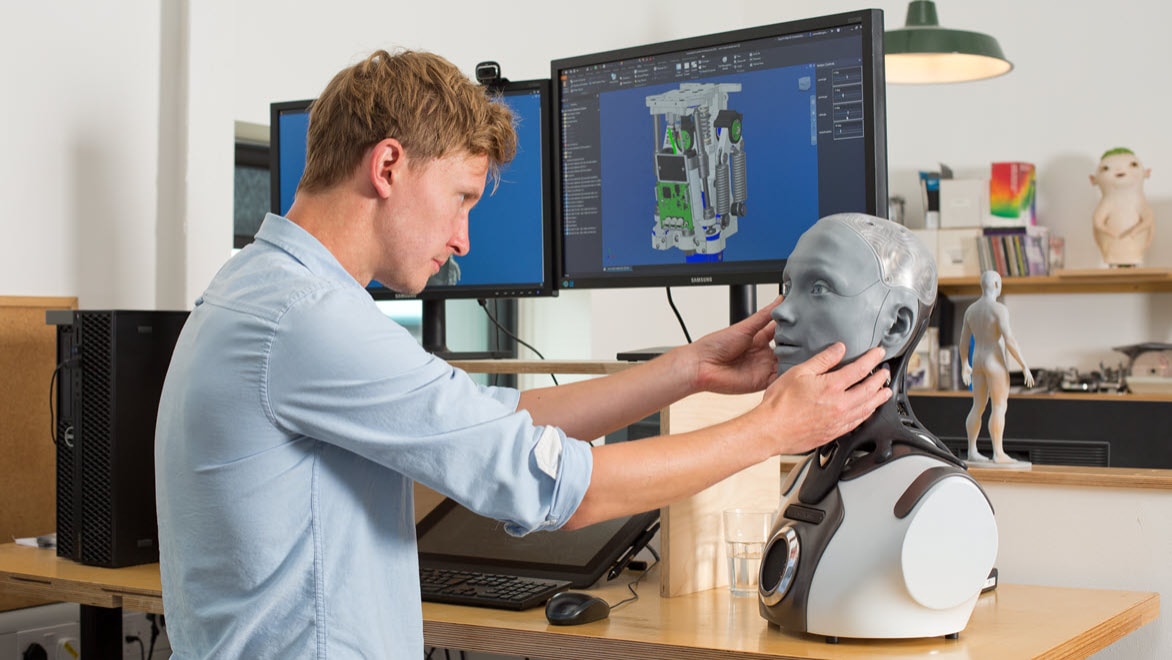
Mechanical Engineer Simon Osborn works on the desktop version of Ameca
Big innovations in small spaces
When you think of the design challenges of humanoid robot design, you may skip ahead to the articulation of eyebrows or the authentic representation of human skin. And you would be right — those are both critical aspects of leading-edge humanoid robotic engineering.
But looming over all of these discrete problems is the issue of space. Namely, a humanoid robot must find a way to package a multitude of components within the confines of a typical human form.
“The primary challenge we are trying to solve is volume,” says Simon Osborn, Senior Mechanical Design and Engineer for Engineered Arts. “Before we can address anything else, we have to work out the confines of the problem. Typically, it is a human-sized form. And that means you can’t have a robot that is supposed to look like a person but has giant arms to fit really big motors.”
A Human-sized form
To establish the design envelope, Engineered Arts starts with a variety of data capture techniques, including photogrammetry and 3D laser scanning. This phase also captures physical movement and emotional representations, which are obtained in a similar manner to the “dots on faces” techniques used in motion capture for computer-generated imagery (CGI).
All of this data is then brought into Autodesk Inventor to give the team an accurate representation of the entity they need to emulate as well as the available space they have to do it.
“The primary challenge we are trying to solve is volume. Before we can address anything else, we have to work out the confines of the problem. Typically, it is a human-sized form. And that means you can’t have a robot that is supposed to look like a person but has giant arms to fit really big motors.”
—Simon Osborn, Snr Mechanical Design Engineer, Engineered Arts
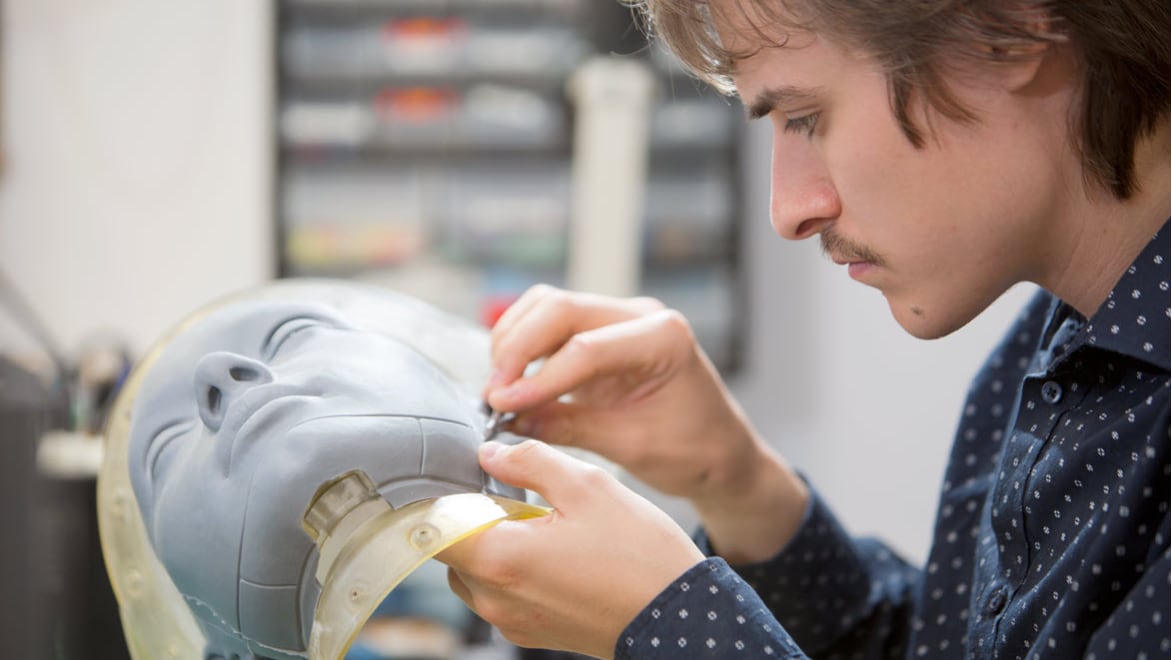
Bren Carter works on the face of Ameca
Text + Image (Right)
“Most of the time, we are creating a robot that looks like a specific person, whether that’s a historical figure, a character from a movie, or an athlete,” Osborn says. “That’s why we capture as much of the actual physicality as possible, whether we are creating an entirely new module or adapting an existing approach to a new physique that requires different kinds of movements.”
It may seem obvious, but the movement of the robot is what makes robotics such a challenging and compelling field of design and engineering. Replicating a person in a static form — whether it is a digital image or a wax museum-style replica — is the (relatively) easy part. What separates the various classes of robotic devices is the degree to which they can move.
Text + Quote (Right)
“Our earlier generation robots tend to use big, broad gestures, similar to those of a Shakespearean actor, where you’re communicating in a way that can be understood at a distance,” says Leo Chen, who leads all US operations for Engineered Arts. “The more advanced robots are emoting through the face, which requires articulation of the eyes, eyebrows, and a variety of facial muscles.”
Chen notes that there are many robots that look very realistic — until they start moving. What sets Engineered Arts apart is the company’s ability to accurately recreate specific individuals while also incorporating a range of emotional expressions and smooth physical movements.
“We added Inventor long before I joined, but I’m glad it was selected. It has allowed us to create a lot of impressive designs. It’s very engrained in our work at this point. Many of our processes are based in Inventor.”
— Simon Osborn, Senior Mechanical Design and Engineer, Engineered Arts
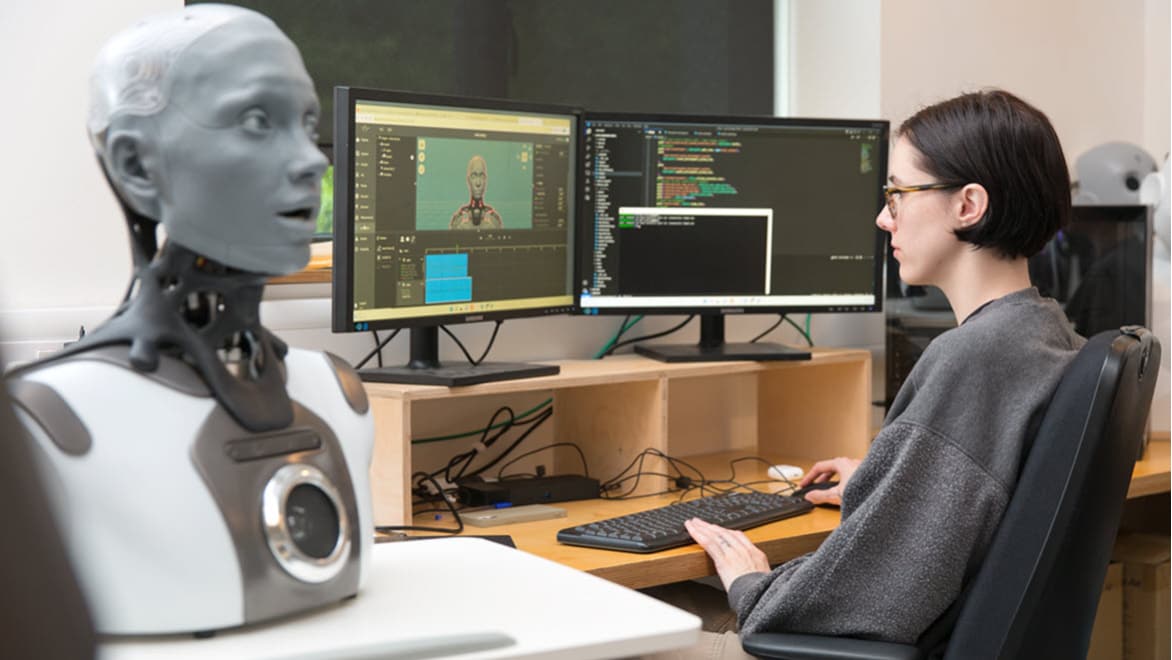
Mac Madison programming Ameca's movements using Engineered Arts propriety visual programming software 'Virtual Robot'.
Animation first, engineering second
Because of the need to represent both large and small motions, the Engineered Arts team follows what they refer to as an “animation first” design principle. This approach dictates starting with the outline of a desired movement in order to establish the design constraints, as opposed to starting with a particular type of mechanism.
“The temptation with any kind of robot is to say it pivots here and here, so this needs to be a milled part and this needs to be a turned part,” Chen says. “Unfortunately, that can lead to a situation where you realize too late that the robot doesn’t really move at all like a human. That’s why we establish very early on how the robot should look in motion and only then build the mechanisms required to reproduce that motion convincingly, not the other way around.”
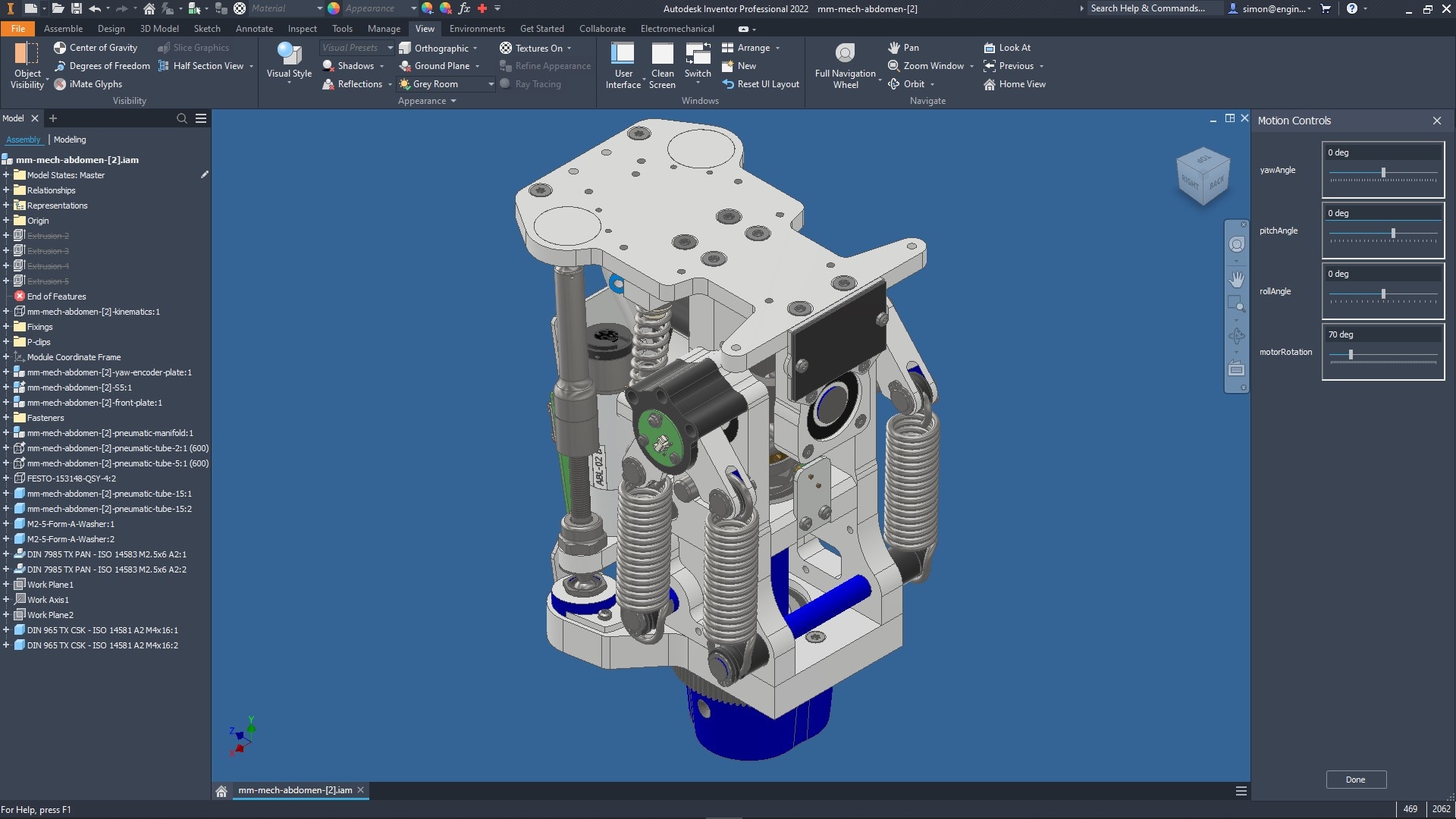
The Ameca Humanoid Robot being designed with Autodesk Inventor - Screen image courtesy of Engineered Arts
Text + Image (Left)
Teams at Engineered Arts often rely on model states within Inventor to show the constraints of all the various configurations of an assembly. Using custom user interface forms within Inventor’s iLogic functionality , engineers can drive constraints using parameters to quickly see all the transitions the robot goes through while smiling, for example.
“We get a quick snapshot of how the robot will look while it is performing a specific movement, such as smiling, and see how it transitions through and where any collisions occur,” Osborn says. “You don’t have to write any code, which is great. You just use the form to animate it and see how it looks. We use that approach very early on in the process.”
Text-only; 2 columns
Later on, Engineered Arts uses a tool called Virtual Robot, which is part of the company’s Tritium operating system, to evaluate animated movements digitally. Most of the robots the company produces are installed at customer sites, so there are not very many available in house for testing. The Virtual Robot platform lets designers manipulate joints and pre-program animations in a totally virtual environment to evaluate the realism of each motion.
“Whether our RoboThespian event host is doing a Darth Vader impression or our Ameca robot is introducing a TV show, we can look at it on screen before transferring the instructions to the physical device,” Chen says. “Virtual Robot uses key frames with hard stops built in, for example a 120-degree actuation angle on an arm. It’s really a tool for rapid iteration. Again, you animate first, then get the robot to replicate that motion.”
Overall, animation-first thinking is what empowers the Engineered Arts team to solve design challenges in a different way than is typical in the field of robotics.
“Balance is another big challenge we are trying to solve all the time,” Osborn says. “As soon as a robot lifts itself or swings its arm around, it can affect the balance of the entire mechanism and throw everything off.”
While a more traditional engineering approach might solve this problem by incorporating more powerful motors, the Engineered Arts team takes a more holistic look at the situation.
“We look at the range of motion necessary and then ask if we can counterbalance the force we are fighting, which is gravity,” Osborn says. “That leads us to ask if we can first incorporate springs and counterweights before we consider bigger motors, which lets us keep smaller motors that can move faster, which makes our robots more efficient overall.”
Text-only; 1 column
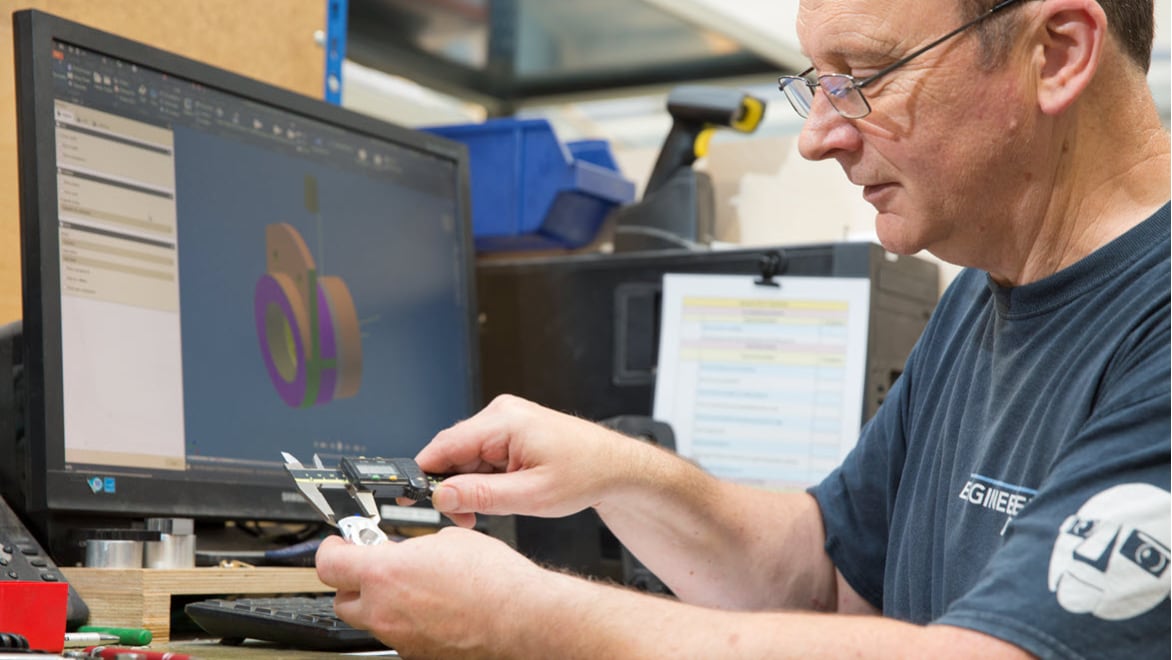
Chris Parker programs Ameca parts for CNC machining with Inventor CAM
Mechanisms of action
Of course, Engineered Arts is also a manufacturer. And like any manufacturing organization, it seeks to optimize efficiency in design and production.
So after the animations are mapped out and the robotic components are specified, the team uses high-quality mesh data within Inventor to piece together the various modules involved to see what will fit within the prescribed design area and what will not, as well as which existing modules can be reused and which ones will need to be developed from scratch.
Osborn notes that one constant design challenge that may not be immediately obvious to engineers outside the field of robotics is the natural asymmetry of the human form.
“You may not realize at first how asymmetric people are, which creates unusual design problems in robotics,” he says. “Just because you’ve solved an animation issue on one side of the robot doesn’t mean you can copy it to the other side. It won’t look right. Each half of the face and body presents similar challenges, but they’re not exactly the same. There is a great deal of nuance.”
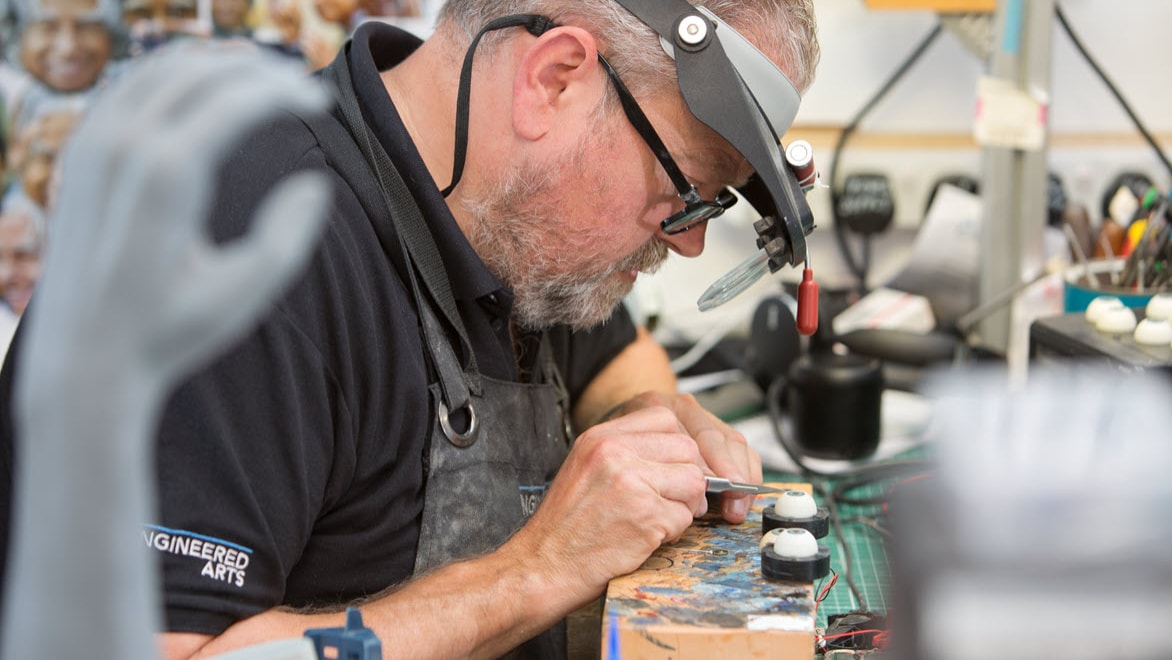
Michael Humphrey creating Amecas eyes
Beyond the human form
Engineered Arts produces much more than human replicas, however. In many cases, customers are seeking a robot that looks like a robot — or something else entirely.
“With our Ameca platform, we designed it specifically to look like a robot, so we could deviate from the human form,” Chen says. “For example, you can see through the neck. It was very liberating to have that degree of license.”
In another high-profile example, the Engineered Arts team built two “life size” King Kong heads in conjunction with the release of the film Kong: Skull Island. Each robotic head is interactive, equipped with laser ranging sensors that can detect people nearby, so the giant ape’s eyes follow them. Not only do Kong’s eyes and lips move, but if someone stands in front of the head, he delivers a blast of air and a sufficiently terrifying roar.
Museums and exhibitions are not the only destination for the company’s products, either. Robots from Engineered Arts are used in a variety of specialized testing applications, including virtual reality devices, “smart” eyeglass products, and driver assist technology.
Two decades of innovation
Engineered Arts started operations in 2004 and began using Inventor shortly thereafter. Nearly two decades later, the software has become second nature for the company’s design and engineering teams.
“We added Inventor long before I joined, but I’m glad it was selected,” Osborn says. “It has allowed us to create a lot of impressive designs. It’s very engrained in our work at this point. Many of our processes are based in Inventor. We’ve even created an ERP system that plugs directly into Inventor to create build instructions, do billing, and perform other tasks.”
Inventor also allows the Engineered Arts team to move quickly during design review, sharing read-only in-process design work with stakeholders who do not use Inventor.
“The read-only feature is super useful for showing off a design internally to people who don’t need to use Inventor every day,” Osborn says. “Ultimately, that helps us continue to run lean while maintaining the mix of productivity and innovation required to capture a lot of market share.”
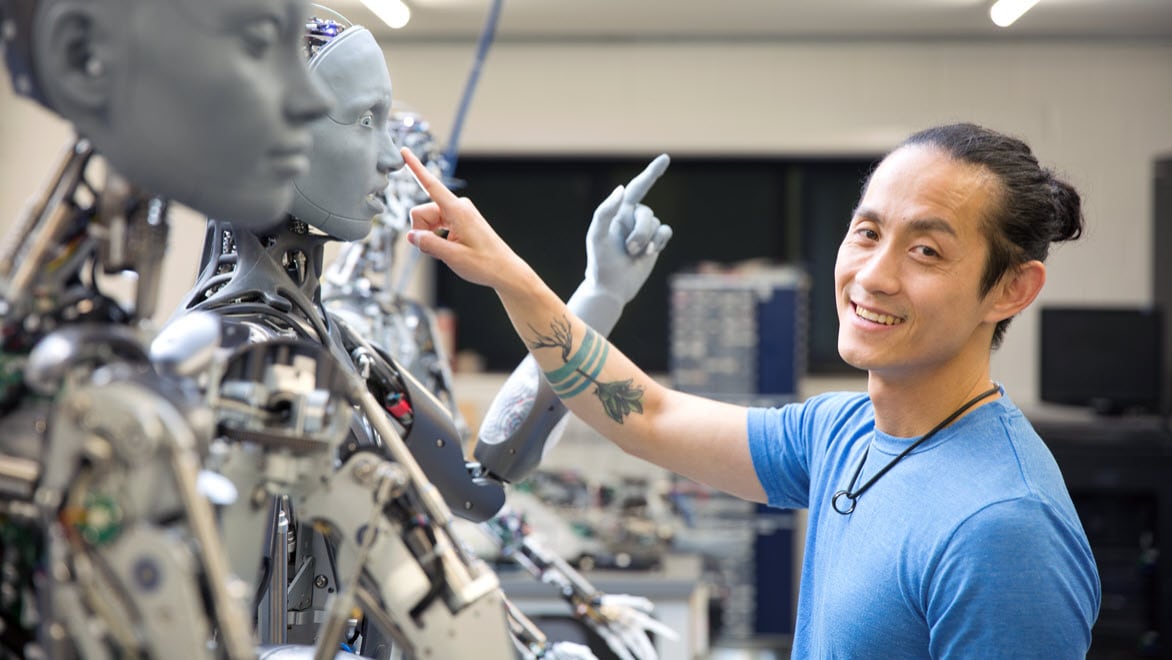
Leo Chen of Engineered Arts and Ameca the Humanoid Robot
Text + Image (Left)
For Chen, the company’s original decision to use Inventor is even more personally relevant.
“I wouldn’t have a career here without Inventor,” he says. “During the pandemic, Engineered Arts was building the platform that became Ameca. In order to justify my position as lead of US operations, they had to iterate very quickly and develop Ameca is just three months. It just wouldn’t have happened without Inventor. It was fundamental to the success of our business.”
Photos courtesy of Engineered Arts.
Related Links
The Product Design & Manufacturing Collection is an integrated set of professional-grade applications that connect everyone, from concept to production, with shared tools to streamline your product development process. The collection enables you to create your most ambitious ideas, collaborate efficiently, automate busywork, and explore more design options than ever before.